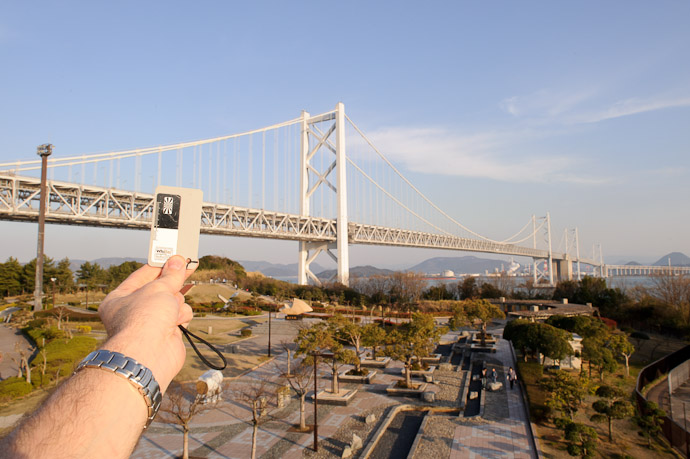
Nikon D700 + Nikkor 24mm f/1.4 — 1/400 sec, f/16, ISO 900 — map & image data — nearby photos
Just Checking the Light
with the 1,723-meter Minami Bisan-Seto Bridge in the background
between Honshu and Shikoku, Japan
On our short trip to Imabari a couple of months ago, after leaving the oddly-interesting Towel Museum we made our way back to Kyoto via the Great Seto Bridge, the collective name for a bunch of large double-decker (cars on top, trains below) bridges that span about six miles of the Seto Inland Sea between Shikoku and Honshu, the smallest and largest of the four islands that make up the bulk of Japan.
The route we took on the outward leg of the trip crossed to Shikoku via the much longer Shimanami Kaido, hopscotching over a bunch of fairly large islands for 30 miles, but today's series of bridges had only one island big enough for anything more than a pier, and on it was a small rest stop.
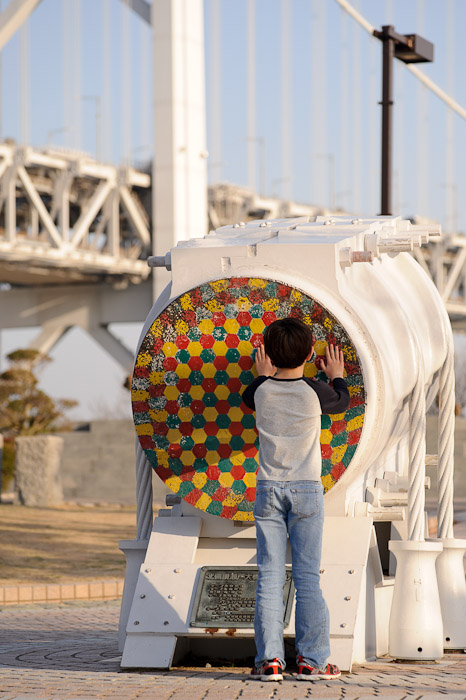
Nikon D700 + Voigtländer 125mm f/2.5 — 1/1250 sec, f/4, ISO 200 — map & image data — nearby photos
Suspension Cable Cross Section
Anthony checked out the cross section for one of the suspension cables for one of the bridges, and was amazed as I explained how it all worked. The wire bundles are an even meter thick, with 29,718 individual strands each a fifth of an inch thick.
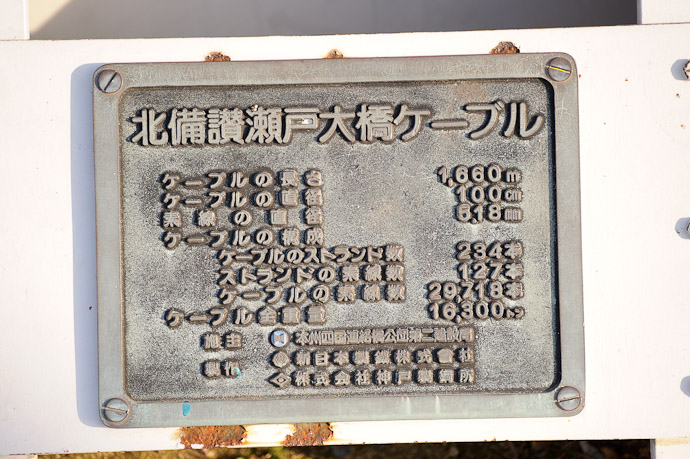
Nikon D700 + Voigtländer 125mm f/2.5 — 1/1250 sec, f/2.5, ISO 200 — map & image data — nearby photos
Stats on the Bridge Cable
for one of the five bridges that make up the cross-water route
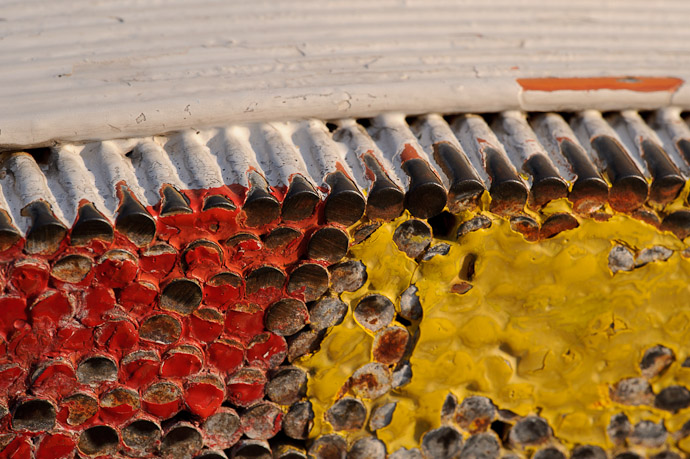
Nikon D700 + Voigtländer 125mm f/2.5 — 1/400 sec, f/11, ISO 900 — map & image data — nearby photos
Strand Closeup
The suspension cable for this particular bridge runs 1,660 meters (a hair over a mile), so the strands in the pair of cables that make up that span, if laid end to end, would run more than 61,000 miles. That's a lot of wire.
(That's a lot of wire, but it's nothing compared to the cable for the third route across this particular sea, the Akashi Straights Bridge that I posted about in 2008, whose cable strands laid end to end would reach almost 190,000 miles.)
On a national holiday this rest area is filled to capacity, but it was almost empty while we were there, which was nice. This couple was enjoying the sights with their dog...
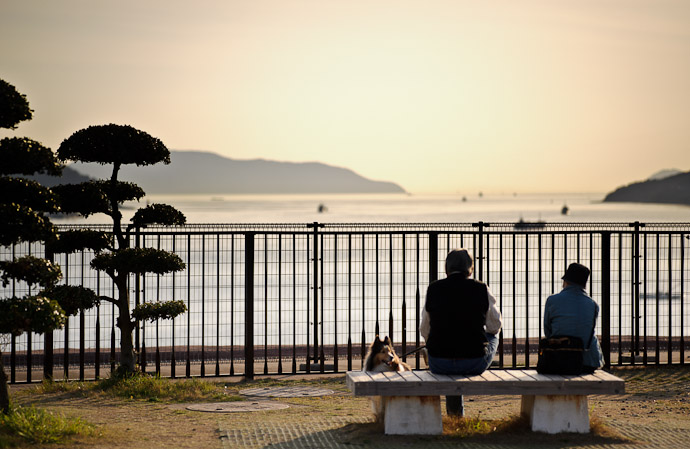
Nikon D700 + Voigtländer 125mm f/2.5 — 1/4000 sec, f/2.5, ISO 200 — map & image data — nearby photos
Sunset Approaches
The day was extremely hazy with the kosa airborne sand I talked about in “Misty Evening in Rural Japan” and “Descending Into a Volcanic Crater”, so the approaching sunset took on an odd color.
Futzing around with these photos in Lightroom, I ended up with a stark B&W version of one of these that I sort of like...
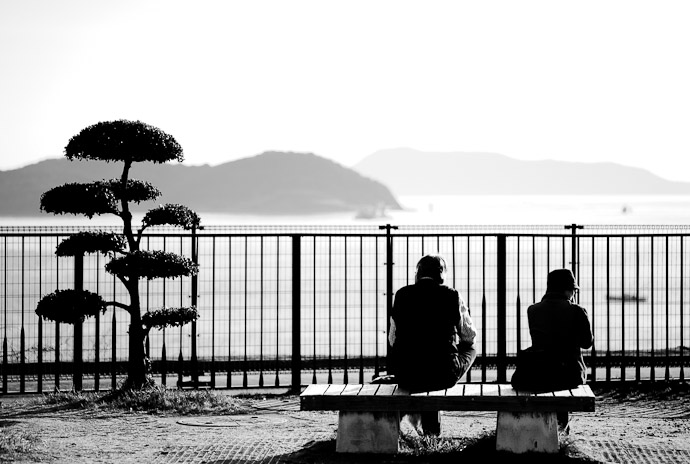
Nikon D700 + Voigtländer 125mm f/2.5 — 1/4000 sec, f/2.5, ISO 200 — map & image data — nearby photos
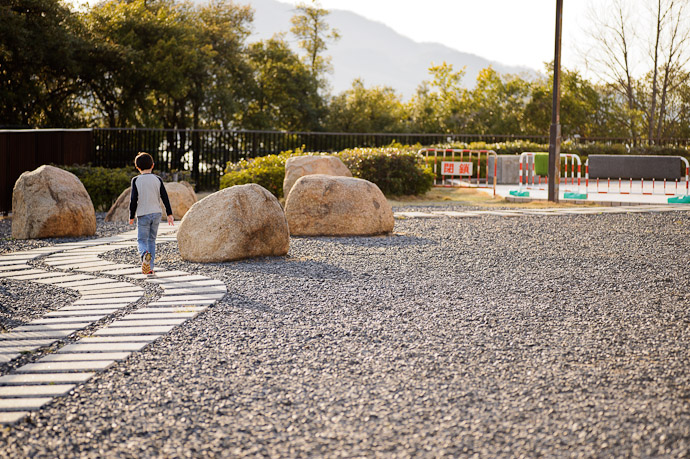
Nikon D700 + Voigtländer 125mm f/2.5 — 1/1000 sec, f/2.5, ISO 200 — map & image data — nearby photos
Path
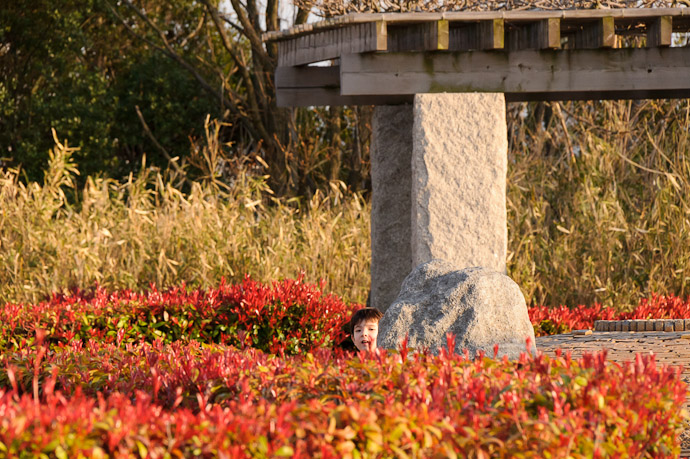
Nikon D700 + Sigma “Bigma” 50-500mm OS @ 500mm — 1/400 sec, f/16, ISO 2000 — map & image data — nearby photos
American Ninja
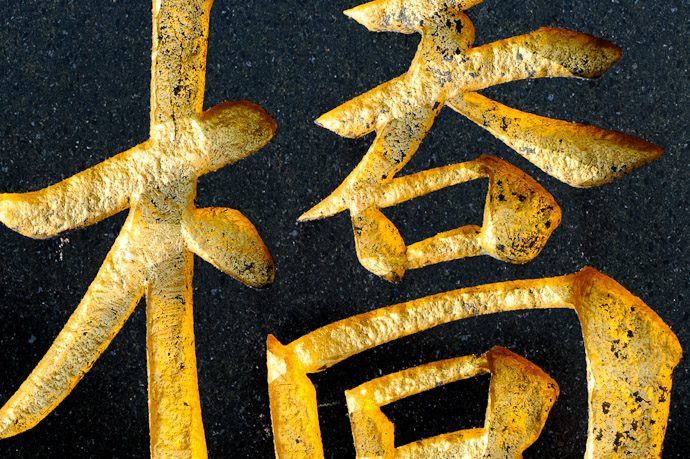
Nikon D700 + Sigma “Bigma” 50-500mm OS @ 240mm cropped — 1/500 sec, f/6, ISO 200 — map & image data — nearby photos
Bridge of Distinctive Character
close of up a gold-painted「橋」(bridge) engraved in black marble
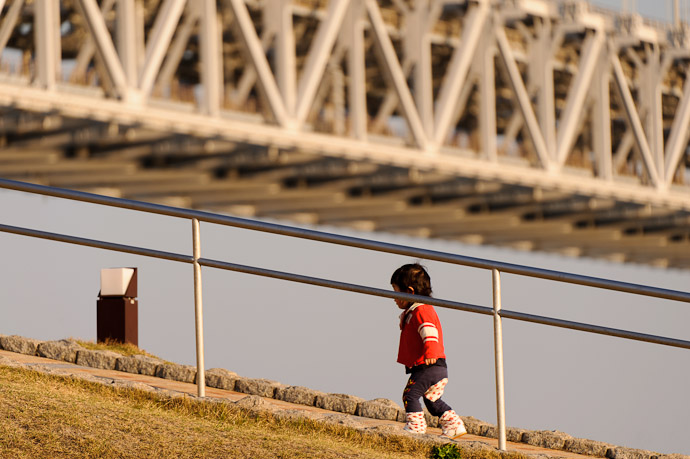
Nikon D700 + Sigma “Bigma” 50-500mm OS @ 290mm — 1/800 sec, f/6.3, ISO 200 — map & image data — nearby photos
Modes of Transport
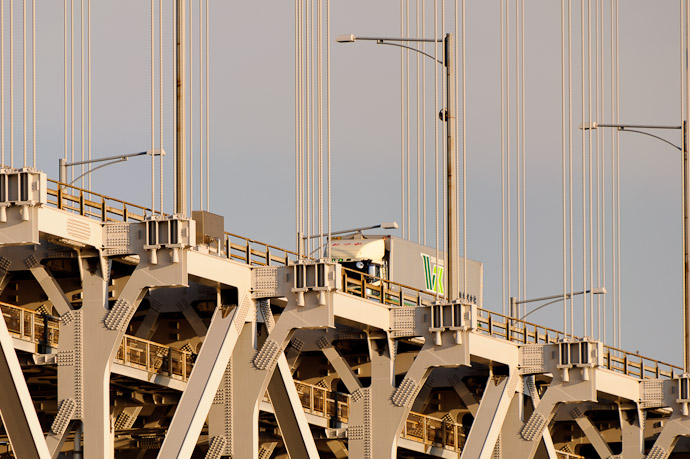
Nikon D700 + Sigma “Bigma” 50-500mm OS @ 500mm — 1/800 sec, f/6.3, ISO 200 — map & image data — nearby photos
Truck
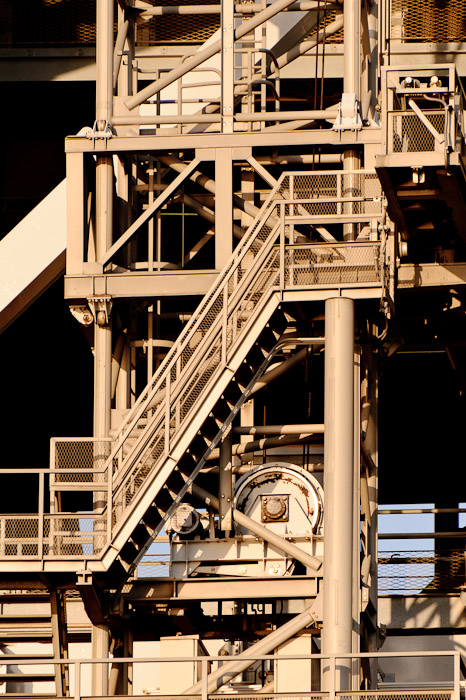
Nikon D700 + Sigma “Bigma” 50-500mm OS @ 500mm — 1/800 sec, f/6.3, ISO 200 — map & image data — nearby photos
Inter-Deck Access
likely for maintenance and emergencies
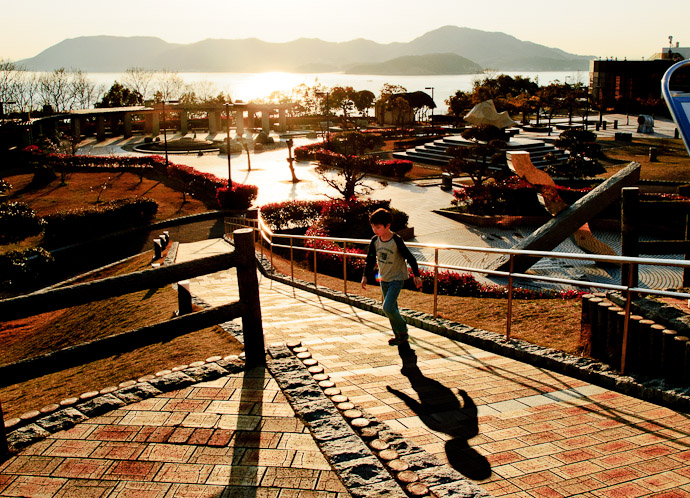
Nikon D700 + Nikkor 24mm f/1.4 — 1/400 sec, f/16, ISO 320 — map & image data — nearby photos
Late Afternoon
Stylized
After a rest, we hit the road again, rising up from the island to the upper deck on a series of flyways connected by a 360° mid-air spiral...
This reminded me of the several similar mid-air loops we'd seen during our suspension-bridge bike ride the previous day, over a different set of bridges 50 miles away.
So, in now having taken all three routes to Shikoku in the last year (two routes during this trip, and last year the eastern Awaji route with its pair of big bridges, seen here and here), we've been on the eight longest suspension bridges in Japan.
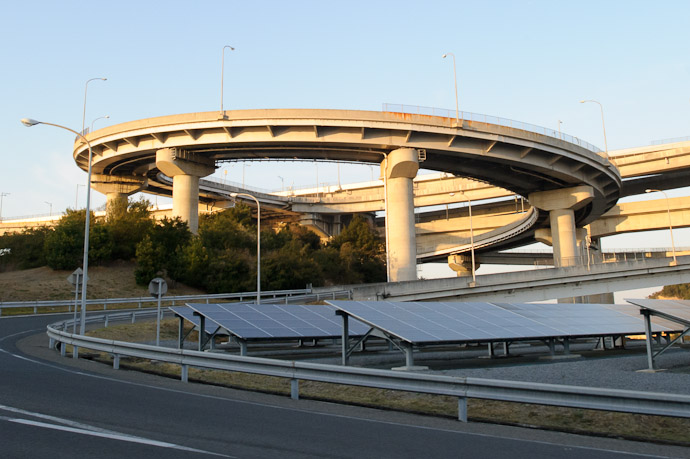
Its really cool to see the ‘public works’ in Japan. In this photo spread you have shown shots of benches, bushes, walkways & paths. I guess if you live there a long time or are native you don’t notice it but all that stuff looks so cool. I love the way they incorporate that modern public look with classic iconic Japanese design concepts. STYLIZED looks so inviting… that afternoon sun… brand new park… I’m 40 years old and I’d love to play tag or some other kid’s game in there.
Wonder how much Shikoku has changed, if any, since the bridge opened and access to it from Honshu is now easier?
Beautiful shots as always.
I notice you’ve started including shots of your white-balance card, which leads me to ask — could you describe your exposure workflow sometime? I get the impression that you have a preference for short DOF, from which I would assume you choose the aperture first; but do you use the camera on auto (aperture priority) metering, or do you also use the WB card to determine the appropriate shutter speed and shoot in manual thereafter?
When sitting down to compose a post, I don’t set out with the intention of showing a picture of my white-balance card, but in this case it was the best picture I had showing the park. If this were a photo blog instead of a “stuff I want to write about” blog, I wouldn’t have included it nor half the photos. My use of the WB card has nothing to do with exposure or aperture. It’s a color-neutral material (it reflects all visible wavelengths equally), so later in Lightroom I can use the white-balance eye dropper to sample its color: if it has a color cast, it’s coming from the light, so Lightroom can compensate the color computations to remove it. Depending on the situation, the result suddenly snaps into “yeah, that’s how I remember it” color, or not, but I find it generally useful to have as at least a starting point. If the light illuminating a scene is consistent across a set of photos, you can then copy the WB setting from that photo to the others, so they all become corrected. This doesn’t work if the sun is popping in and out of clouds, or the subject is in and out of the shade, for example. Again, none of this has anything to do with the exposure, but FWIW, I use aperture-priority (I set the aperture to what I want and let the camera adjust the ISO and shutter speed). —Jeffrey
Thanks for the explanation. You may not intend this to be a photo blog, but I for one learn something new from it every now and then.
I notice in my own outdoors shooting that automatic metering sometimes (not often, and not predictably) gets it all wrong, so I wondered whether you were spot-metering the WB card as an 18% grey reference and then using the calculated shutter speed manually.
No, never done that with the small WhiBal. I do often use spot/center metering, and I check histograms on the back of the camera occasionally, and sometimes exposure lock before recomposing. Another technique I use often is to get it wrong and spoil the shot. This is one of the many things that separate me from a good photographer, but the digital age allows me to compensate to a fair degree. —Jeffrey
Whats the name of the card and how does it works? Thx
It’s a WhiBal. It’s very simple to use, as I described in a comment above. —Jeffrey